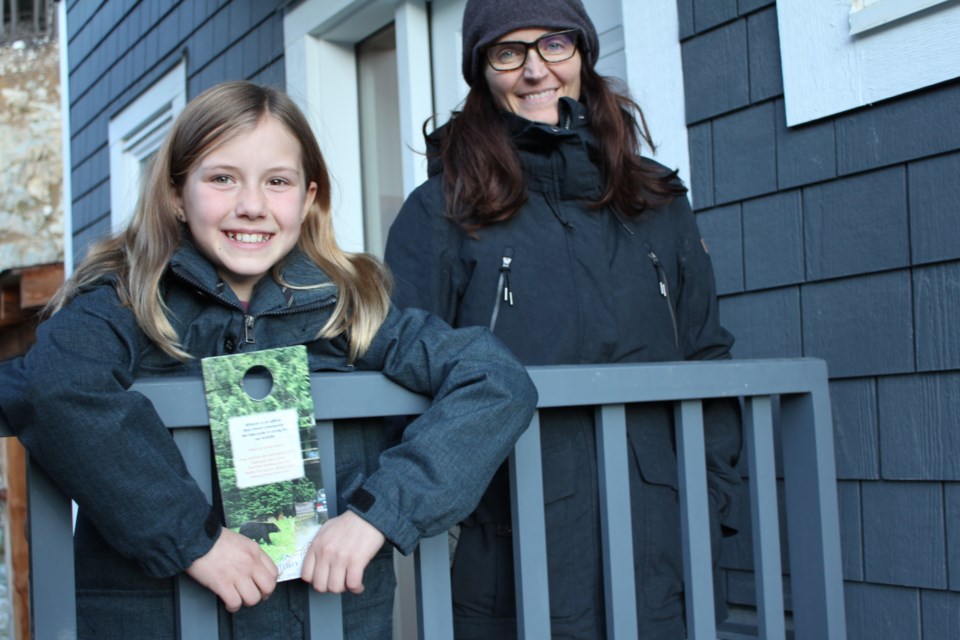The Whistler Get Bear Smart Society is launching a neighbourhood watch program that aims to mitigate human-bear conflict and raise awareness of wildlife issues in the community.
"The Get Bear Smart Society is receiving phone calls from residents who are concerned," explained Bear Smart's Nicole Fitzgerald."We want to take that passion and that concern for our environment and our animals and feed it in a productive way that is going to be proactive."
The resort's first neighbourhood watch group was actually initiated by 11-year-old Rainbow resident Marlee Peterson, who grew concerned for a yearling bear she had seen roaming the neighbourhood.
"I didn't want the bear to freeze," said Marlee when reached by phone.
After asking her mother what could be done, Deb Peterson contacted Bear Smart for advice. That led to a canvassing campaign this past weekend when volunteers went door to door to inform residents of the bear in the area as well as educate them on potential attractants, such as road salt.
"The big thing right now is people leaving bags of salt outside. This is a wildlife attractant, so the group of volunteers that went out to Rainbow on Saturday and Sunday this weekend basically took the time to educate people," Fitzgerald noted.
Bear Smart has also been in contact with the Whistler Housing Authority to remove rose hip from the neighbourhood after several residents had reported seeing bears feeding on the bushes.
Fitzgerald encouraged anyone interested in starting their own neighbourhood watch group to contact her at [email protected].
"The goal is to create community-led groups in each of Whistler's neighbourhoods," Fitzgerald explained. "A local resident initiates this process by volunteering to become a leader for their neighbourhood with the Get Bear Smart Society. This leader will become the communication line between their area and the Get Bear Smart Society." Neighbourhood leaders will undergo a short, one-time training session by phone, in which they will be given guidance and resources to help their neighbours better understand and report the needs of bears specific to that area, Fitzgerald said.
The organization's effort comes just days after two male bears were relocated out of Whistler in separate incidents. The first occurred on Nov. 26 when a bear was reportedly seen pawing at the window of a home in Alpine. Conservation officer Tim Schumacher said the large adult bear had no known history of conflict and was not ear-tagged. There were also similar reports recently of a bear pawing at a window in Whistler Cay, and Schumacher said officials "are unsure if it's the same bear or not, but it very well could be given the close proximity."
On Dec. 1, another bear was tranquilized and relocated out of the resort after it was spotted feeding on garbage in Olympic Plaza. ""It looked like it was eating some canned food and beer cans, so obviously there were some attractants left in the park at Olympic Plaza," said conservation officer Brittany Mueller.
The ear-tagged bear was also relocated last year after it was seen eating garbage in Day Lot 1.
After an unseasonably warm fall, Mueller said there is still "the odd bear roaming around," but with temperatures dropping in recent days, she expects bears to go into hibernation "in the next week or two." In some cases, however, bears will not go to den as long as there are food rewards to be found.
COS COMPLAINT UPDATE
In October, a sow bear died in a fall after it had been tranquilized by a conservation officer and climbed a tree in Creekside. The bear and her three cubs had reportedly eaten berries from a mountain-ash tree in the residential neighbourhood. The cubs were not relocated, stoking fears that they may not survive the winter on their own.
The incident prompted outrage from the community, as well as a formal complaint lodged by the wildlife advocacy group, the Fur-Bearers, which was critical of the COS for not having a capture net onhand that could have broken the bear's fall and for tranquilizing a bear that didn't appear to pose a threat to the public.
The COS is mandated to respond to the Fur-Bearers' formal complaint. Chris Doyle, deputy chief of the B.C. Conservation Officer Service, said the Crown agency had not yet filed its response, but that it was "coming soon."
Doyle also confirmed the local COS has acquired two capture nets that it will now test for operation. They are expected to be ready for deployment by the start of next bear season.
In the past, the COS has struggled to find a capture net that was both large enough to absorb a bear's fall and could be deployed by a single officer, if need be. "This is a new design that was demonstrated to us recently at an international bear-conflict workshop. When we saw the design, we thought it could work for us in some situations," Doyle said.
With only a handful of officers covering an area stretching from the Sunshine Coast to the Sea to Sky, Fitzgerald hopes the neighbourhood watch groups can help fill the gaps the COS can't.
"When you look at the COS and how much resources they have as far as numbers, it's completely impossible to think that a handful of people can manage an area this big, with as many people we have coming into the area and with the number of bears that reside within the resort," she said.




